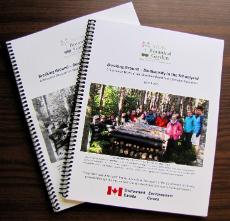Educational Resources
The MUN Botanical Garden education staff have released several publications over the years to help educators, parents, and caregivers to incorporate natural history, biology, and botany into all areas of a child's educational adventure.
It is through the cooperation and support of Garden staff, program participants, other environmental educators, and various funding sources that we have been able to develop such comprehensive educational resources.
From Garden to Classroom: Is a set of botany-related activities and resources that can be incorporated across the curriculum and be adapted to suit a wide range of ages
Breaking Ground: This comprehensive guidebook contains activities and resources to encourage biodiversity in the schoolyard.
Composting Curriculum Unit: All you wanted to know about composting in Newfoundland, as well as a list of composting-related activities and resources to be incorporated into the curriculum.
PlantWatch Newfoundland and Labrador: This classroom program has students participating in a Citizen Science program watching the flowering dates of common Newfoundland plants. The change in dates over time can be related to climate change.
Botanists require a variety of skills in order to train and work as a botanist. The following resources will introduce several basic skills, useful for a botanist.
Videos
- How to Make a Newspaper Flower Pot
- Sprouting Peas
- Celery Straws
- Roots and Shoots
- How to Build a Pop Bottle Terrarium
Videos:
How to make a newspaper flower pot
How to Build a Pop Bottle Terrarium
Canadian Outreach Guide to Plant Biodiversity Education website
Useful skills for a botanist include:
Propagating is the process of increasing your volume of plants and it is commonly done by germinating seeds and through divisions and cuttings. All of these activities can easily be done in the classroom or at home and are useful when learning about plants.
One of the first steps in becoming a botanist is to venture out and collect some plants from your local area. The Budding Botanist activity is a simple way to botanize, even in winter.
3. Plant Identification
Learning to identify plant species starts with learning to observe plants, both indoors, in the wild and in your garden. A variety of simple dichotomous keys have been developed to help 'key out' or identify common plants from a local area. Two keys for Newfoundland trees and shrubs, developed by Dr. Michael Collins Dr. M.A.J. Collins and published in the booklet Winter Ecology (Oxen Pond Botanic Park, Memorial University of Newfoundland, 1976). It is a very useful tool when learning to identify some common evergreen shrubs and trees in Newfoundland and Labrador.
How will you know if it is native or an introduced plant? There is no simple answer to this question. If it is growing in a garden, there is a good chance the plant is not native (but there are no guarantees). Similarly, if it is growing behind your cabin, it might be native. Having said that, garden escapes are common, even from one hundred years ago, so any plant growing near an old settlement, graveyard or cow pasture could be introduced. Local gardening centers, gardening clubs and botanical gardens can help you identify your plant. Try to supply a synopsis of your data, including sketches and photographs if available to aid in identification. The good news is, you and your students will quickly become skilled observers and you will learn each plant’s identity as you go.
4. Botanical Basics
Here are some botanical basics resources to help you learn more about plants.
